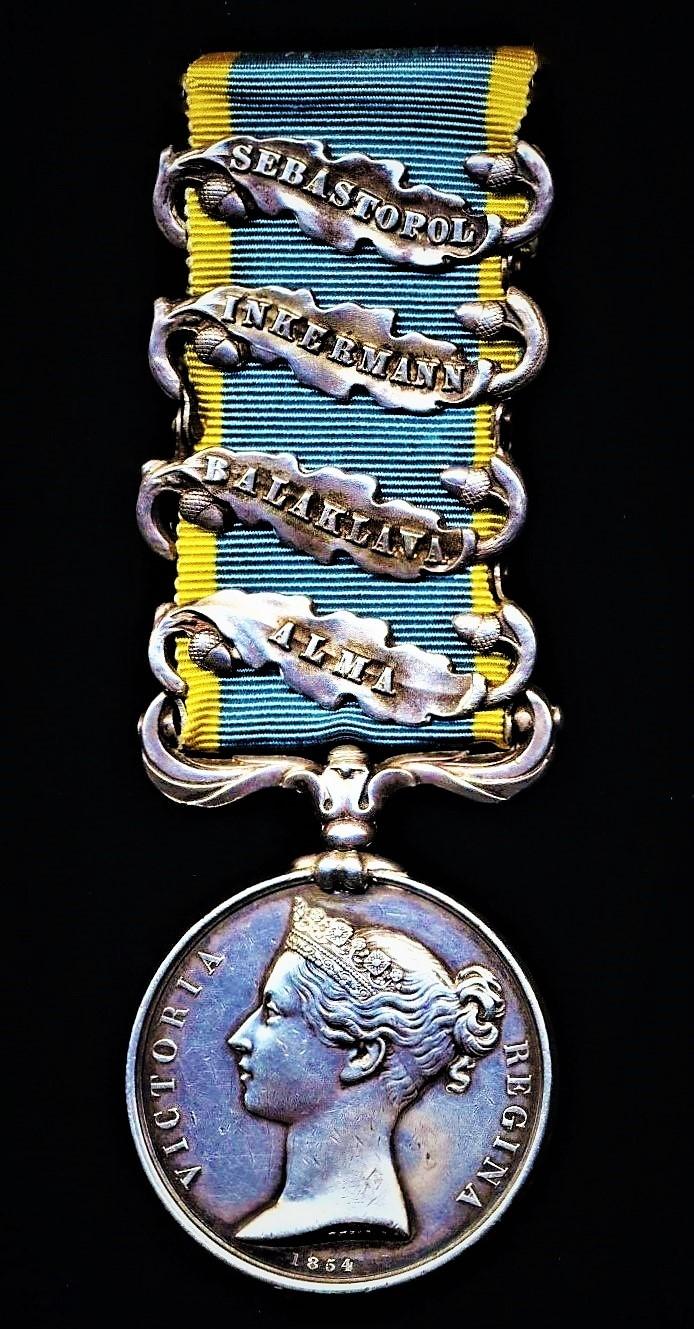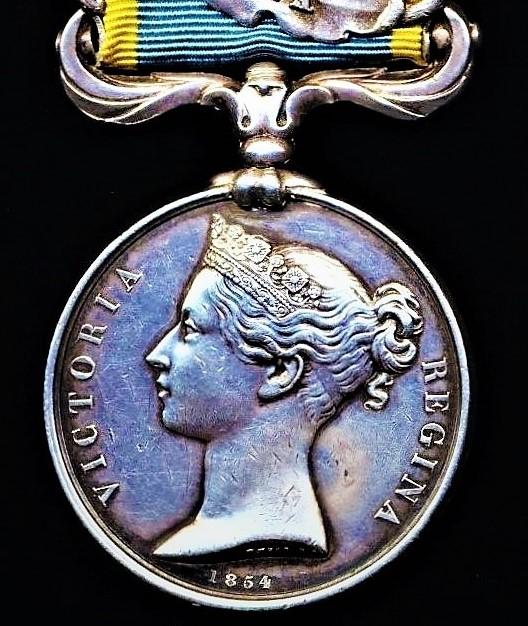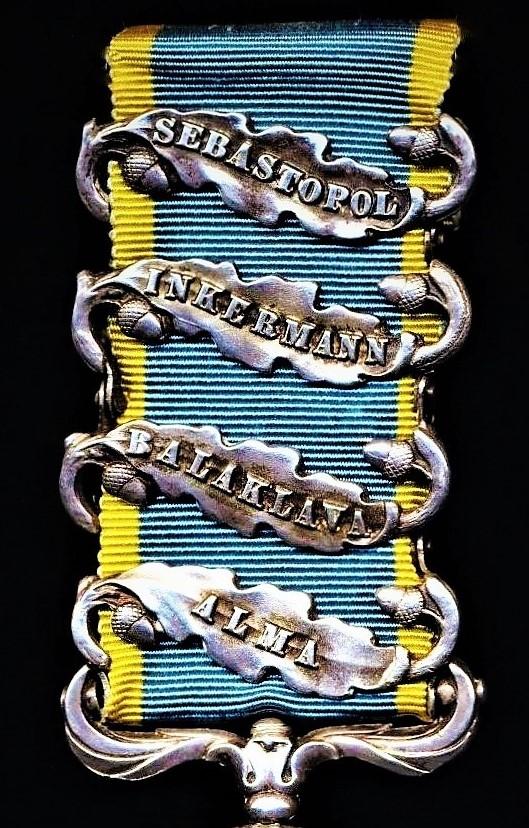Crimea Medal 1854-56. With 4 x clasps 'Alma' 'Balaklava' 'Inkerman' & 'Sebastopol' (Dvr Marshall. Regnall. R.H.A.)
Naming: The naming is officially engraved in serifed capitals by Hunt & Roskell
Clasps: Mounted in correct order of precedence, and all rivets are official expect for one unofficial rivet on the second clasp
Note: Medal & all 4 x clasps clasp verified as entitled per the respective campaign medal roll of 'I' Troop, Royal Horse Artillery (ref WO 100/24), wherein the recipient is correctly shown as No 1790 Driver Marshall Rignall (medal named Regnall sic)
Driver Marshall Rignall saw extensive action in ‘I’ Troop, R.H.A. in the Crimea, including the ‘affair of the Boulganac’, the Alma and Inkermann, but it was at Balaklava on 25 October 1854, as part of Lucan’s Cavalry Division, that he was most heavily engaged. Jocelyn’s History of the Royal Artillery (Crimean Period), referring to 'i' Troop R.H.A. at Balaklava states, it ‘lost many horses and the gun carriages were abundantly marked by bullets ...and a gunner and more than a third of the gun teams horses had been killed, before ‘I’ Troop, with the Greys as escort, descended from the position that had occupied in action.’
As it transpired, ‘I’ Troop returned to the scene of battle in time to witness the charge of the Light Brigade. Luckily, Raglan’s order for the Troop to accompany the Light Brigade ‘rapidly to the front’ was never received, although it did follow the doomed cavalrymen until, as Jocelyn puts it, ‘it became momentarily more and more apparent as the Troop trotted steadily forward that, before it could render any efficient service, the Russian fire would entirely cripple it ... the word was given to go about, and it retired to a position not far from the Heavy Brigade
Marshall Andrew Rignall, son of James Rignall & Mary Rignall (nee Bullman) was a native of, Ely Cambridgeshire, England, where he was born circa 1834. Marshall, by trade a 'Labourer', declared that he was 18 years & 9 months of age when on 17 January 1853, he enlisted into the Brtish Army, at, Woolwich, Kent, and was posted to the Royal Regiment of Artillery, and service with the Royal Horse Artillery. By the time he took his final discharge form the British Army, on 14 October 1856 - due to 'unfitness for further service' - Marshall had served a total of 3 years & 271. During his service in the British Army, Marshall held the rank of 'Driver', and had served 1 year & 6 months overseas during the Crimean War, where he had served with 'I' Troop Royal Horse Artillery. For his services in the Crimea, Marhsall Rignall was awarded he Crimea with 4 clasps, and the Tyrkish Crimea Medal. On the evening of 7 July 1856, while returning with horses at night from Aldershot, Driver Rignall and his horses met with an accident when they fell into a 'Sandpit' near Blackheath, at which time Marshall suffered a serious injury, that ultimately rendered him, unfit for service. At the time of taking his discharge from the British Army, his conduct was described as having been 'Good' and that he had been twice entered in the Regimental Deafaulters' book
By the time of the 1861 National Census for England & Wales, Marshall is recorded as employed on the Staff of a 'Workhouse' located at Sudbury, Suffolk, England, where he held the appointment of 'Porter'. While employed at the 'Workhouse', Marshall, became a 'Whistleblower' when he reported 'Officers' of the Workhouse, the the 'Guardians', with reports of improper abusive (sexual) misconduct by senior staff - not least by the 'Schoolmaster' - who quit his job immediately the claims became known. The abuses at the Workhouse, as reported by Marshall Rignall, became the subject of local scandal and investigation, and were at great length, reported in the local newspapers, reference 'Essex Standard' issue of, 24 December 1862. Marshall, himself claims of abuse levelled at him. Coincidentally the girl cited in the claim made against Marshall Rignall, was the very same woman, Elizabeth Hale, that he subsequently, at St Pancras Parish Church, St Pancras, London, Middlesex on 28 May 1865. Marshall Rignall is recorded as having died at on 1890. Shortly after his death, notices were published in several newspapers, with appeals seeking to raise funds for the widow and family of the dead 'Crimea Veteran'.
Quote (The People, issue, of 16 November 1890),
A BALACLAVA HERO
An appeal is issued by Mr Henry Dann, of Brixton, on behalf of the widow and three children of the late, Marshall Rignall, of 163, Kennington-road. Rignall served in the Royal Horse Artillery under Colonel Maude throughout the whole of the Crimean campaign. He was present at Alma, Balaclava, and Inkerman, and was still in active service when the fall of Sebastopol virtually closed the war. But while preserved from the bullets and bayonets of the enemy, he was twice prostrated by sunstroke, which, with the privations and rigours of the climate, so undermined his constitution that he was discharged as unfit for service, with the reward of a good character, two medals, and four clasps, and sixpence per day pension for one year. Upon returning to this country he found employment at the stores of the Indian Government in the Belvedere-road, Lambeth; but there he met with an accident which injured his spine and precluded him from active employment. It has been suggested that an annuity should be purchased for the widow, and the Hon. and Rev. Canon Pelham, rector of Lambeth, and the Rev. J. H. Walthew, vicar of St, Philips, Kennington-road, have consented to receive donations
Unquote.
‘I’ Troop Royal Horse Artillery was present throughout the campaign in the Crimea, attached to the Cavalry division. At the engagement at Bulganak, the very first land engagement involving the British Army during the Crimean War, 'I' Troop had the distinction of firing the opening guns of the campaign. Together with ‘C’ Troop, they were the only Horse Artillery to qualify for all four clasps, to the Crimea Medal, and and were detailed by Lord Raglan to support the Light Brigade at Balaklava, where during the Battle of Balaklava, 'I'Troop took casualties early in the day in support of the 'Charge of the Heavy Brigade', and later on the same day criss-crossed the ground of battle to the rear of the 'Light Brigade', but were never able to bring their guns into action
The recipients service papers are extant and are held & accessible at The National Archives
A very good Crimean War medal to a veteran 'Horse Artilleryman' whose unit uniquely rode in support of both the Heavy Brigade and the Light Brigade at 'Balaklava'
Condition: GF
Code: 20939







